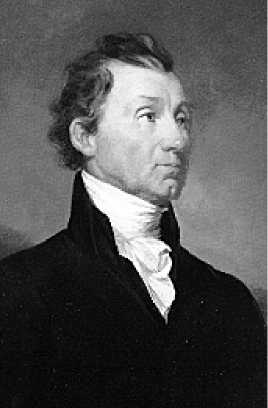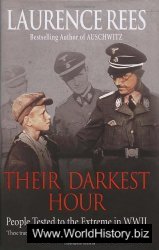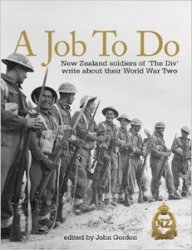James Monroe, who succeeded his fellow Virginian James Madison as president, was Jefferson's law student and protege. Jefferson once remarked that if you turned Monroe's soul inside out, it would be "spotless." Monroe was the last president to dress in the old colonial style. His distinguished cabinet included John Quincy Adams, John C. Calhoun and William Crawford, all three of whom became candidates for President.
Unlike his predecessors Thomas Jefferson and James Madison, James Monroe had served in a military capacity during the American Revolution. As a young lieutenant in the Continental Army, he crossed the Delaware with Washington en route to the Battle of Trenton. He was promoted to captain by General Washington for bravery in the battle and continued to serve with the Army through the winter at Valley Forge and the subsequent Battle of Monmouth. When Major Monroe departed from Washington's army in 1779 for duty in Virginia, Washington wrote of Monroe to a colleague in Virginia, "He has, in every instance, maintained the reputation of a brave, active, and sensible officer."36

By the end of the war James Monroe had reached the rank of colonel. In subsequent years he served in the Virginia Assembly and the Confederation Congress, where he championed the Northwest Ordinance. He then represented Virginia in the United States Senate. His diplomatic assignments have been discussed above. When he assumed the presidency in 1817, he was one of the most qualified men ever to win the nation's highest office. Biographer Gary Hart has described Monroe as America's "first national security president," based on his actions to strengthen America's borders and promote friendly relations with other na-tions.37
Monroe's First Inaugural Address showed that the Republicans had adopted many Federalist Nationalist principles—Monroe supported a standing Army, strong Navy, fortifications, and support for manufacturing. It was said at the time that "the Republicans have out-federalized federalism." But Monroe was still an old Jeffersonian at heart—he vetoed certain bills on Constitutional grounds, the only grounds, it was believed at the time, on which presidents could legitimately veto actions of Congress. (That would change when Andrew Jackson entered the White House.)
Anglo-American Agreements. In the aftermath of the War of 1812, both Americans and Britons were fatigued from decades of struggle. Although America did not fight in the Napoleonic wars, lasting tensions over neutral rights, etc., had kept the country on edge. Thus both parties were disposed to try to secure peace for the future and entered into negotiations to achieve that end. A Commercial Convention of 1815 ended unfavorable trade practices by the British and allowed American access to various markets; an issue that could not be resolved in time of war was thus settled when the two nations were at peace.
The Rush-Bagot Treaty. In 1817 many armaments (naval forces and forts) remained around the shores of the Great Lakes. Furthermore, Canadians were very apprehensive about American expansionist tendencies. British Minister Charles Bagot and American Secretary of State Richard Rush reached an agreement in 1817 designed to reduce tension along the Canadian boundary and avoid a naval arms race. (Minister Bagot in Washington flattered the Americans, calling Dolley Madison a "queen" ) The Rush-Bagot Treaty provided the basis for an unguarded boundary and demilitarization of the Great Lakes. Each side was allowed to keep one ship on Lake Champlain and Lake Ontario and two ships on the upper Great Lakes, one a revenue cutter. The agreement was ratified by the Senate as a formal treaty, and became a model of disarmament. It created the longest unguarded international boundary in the world.
In another follow up to the Treaty of Ghent, Albert Gallatin and Richard Rush in London signed the Convention (Boundary Settlement) of 1818. It provided for the U. S.-Canadian boundary to be set along the 49th Parallel to the Rocky Mountains and provided for joint occupation of the Oregon Territory from there to the Pacific Ocean. The agreement also established the northern Louisiana Purchase border at the 49th parallel. In addition, Americans received perpetual fishing rights off the coast of Canada forever, and a commission was established to adjust territorial disputes.
The Adams-Onis Treaty. In 1819 Secretary of State John Quincy Adams negotiated the Transcontinental Treaty with the Spanish Minister in Washington, Luis de Onis. The Adams-Onis Treaty fixed the southern boundary of Louisiana to the Pacific Ocean and ceded Florida to the U. S. Adams's position was aided by Andrew Jackson's unauthorized foray into Florida, which Spain had difficulty governing. In addition, Mexico was threatening to revolt for independence, and Spain saw much of her colonial empire in America crumbling. The U. S renounced its claims to Texas and agreed to assume $5 million in claims of Americans against the Spanish government. The result of the Adams-Onis Treaty, along with the Rush-Bagot agreement, was that all major border issues west to the Pacific were settled.
The Era of Good Feelings: But with Hard Feelings Beneath
Shortly after James Monroe was sworn in as president in 1817, he made a goodwill trip through New England. A Massachusetts newspaper applauded his visit and declared that the time was now an "Era of Good Feelings." Historians have picked up that phrase, and it is generally associated with the period following the War of 1812. It is true that with the end of the Napoleonic wars and the ratification of the Treaty of Ghent, the world was a much calmer and safer place. Captain Stephen Decatur had neutralized the Barbary Pirates and American trade was free to go forth with its accustomed vigor.
Symbolic of the general feeling of goodwill in the nation, James Monroe ran unopposed for reelection in 1820 and received every electoral vote but one. Although the Federalist Party had disappeared by 1820, some of their nationalist ideas persisted. For example, although Republicans had opposed the national bank in Jefferson's time, Madison had found it inconvenient to run a war without a national financial institution at his disposal, so the Bank was re-chartered in 1816. Madison also felt that a peacetime standing army and a strong Navy were essential safeguards for the country.
The Embargo of 1807-1809 and the War of 1812 had stimulated manufacturing and industry in the United States, and a system of protective tariffs was felt to be useful. As the export of southern cotton drove the economy of that region to new heights, prosperity seemed well distributed throughout the land. Tariffs and land sales provided all the income that the national government needed to support its operations comfortably. The treaties discussed above improved America's relations with foreign powers.
In short, it seemed to be a time of peace, prosperity, and liberty; the Jeffersonian balance between individual liberty and responsible government had apparently been reached. Yet the Era of Good Feelings could not last in a society of so many contending interests. Although the surface of public affairs appeared calm, significant troubles were roiling not far below the surface.
Substantial population growth, improved transportation links within the various sections, and attacks on the institution of slavery contributed to a growing sense of regionalism in the new nation. Powerful sectional loyalties had already begun to undermine national unity. The trans-Appalachian West—with its rich soil and developing system of water transportation— experienced substantial growth after 1790. Native Americans offered some resistance but were pushed aside by the onrushing settlers. The growth in the West typified the incredible population growth of the whole nation. Areas that had been populated by Indians and fur traders became the states of Kentucky, Tennessee, and Ohio, and by 1819 nine new states had been added to the original thirteen. The mix of people in the West led to the creation of a new regional culture of a rootless, optimistic folk. Their interests soon diverged from their Eastern, urban oriented brethren, and the country began to divide along sectional lines.
Differences between different sections of the country were exacerbated by a financial panic which swept across the country in 1819. The lucrative trade that followed the War of 1812 slowed to a near halt, and people lost their jobs in urban areas. Banks failed, mortgages were foreclosed and farm prices took a precipitous drop. The financial problems were not limited to any one area of the country; they swept from the eastern cities to the western agricultural regions. Declining cotton prices hurt the South, and many people blamed the problems on the banks.




 World History
World History









